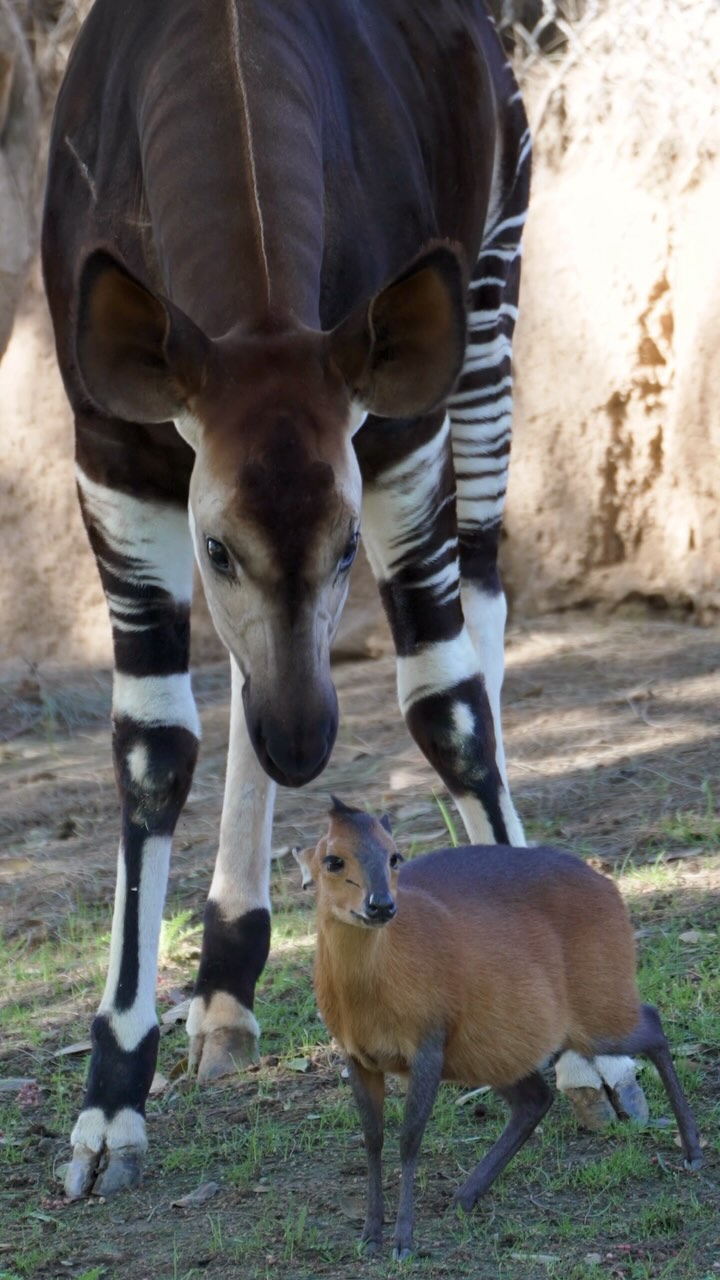- Exploration of friendship dynamics among different species at safari parks.
- The symbiotic relationship between Ruby, a red-flanked duiker, and Bokasi, an okapi.
- The introduction process of new animals in controlled environments within safari parks.
- The role of zoos and safari parks in animal conservation and educational outreach.
- Insights into the feeding and foraging behaviors of okapis and duikers.
At the Safari Park, strolling through the verdant African Woods presents an unusual friendship narrative that captivates both the heart and the mind. As visitors amble through the park, the harmonious sounds of nature are interrupted by an intriguing scene: Ruby, a red-flanked duiker, and her unlikely companion, Bokasi, a young okapi. This duo stands as a testament to the possibility of camaraderie across species, a phenomena that sparks curiosity about the dynamics of interspecies relationships within controlled environments.
Ruby and Bokasi defy the norms, each hailing from distinct African habitats that rarely intersect in the wild. The red-flanked duiker is a small, antelope-like creature, adapting adeptly to dense underbrush and wooded savannahs, whereas the okapi, with its zebra-like stripes and giraffe-like lineage, roams the rainforests of the Congo. Their acquaintance began under the watchful eyes of wildlife care specialists, experts in zoo management and conservation.
Safari park professionals play a pivotal role when introducing new animals into shared habitats. Before Ruby and Bokasi could meet face to face, months were spent facilitating separate explorations within their shared area. This acclimation period involved indirect contact, promoting familiarity with each other’s scents and behaviors. Wildlife specialists leveraged their extensive knowledge to gradually introduce Ruby to Bokasi, ensuring a seamless integration.
In the context of animal conservation and zoological studies, partnerships like that of Ruby and Bokasi offer valuable insights. They facilitate exciting educational opportunities for budding zoologists and conservationists, demonstrating how diverse species adapt and thrive in modified habitats. As visitors learn more about the origins and traits of each animal, they gain a deeper appreciation for the expertise required to facilitate such coexistence.
One fascinating aspect of the Ruby and Bokasi dynamic is their interaction during feeding times. Bokasi’s habits help emulate Ruby’s native foraging behavior. The okapi, primarily a browser, prefers snacking on leaves and branches. As he eats, some foliage naturally falls to the ground. This mimics Ruby’s natural foraging for fallen fruits and leaves in the wild, encouraging her to exhibit behaviors akin to those in her typical African woodland settings. This accidental synergy highlights the intrinsic survival instincts that adapt even in shared settings.
Zoos and safari parks across the globe have been pivotal in conservation efforts, providing safe havens for endangered species and educating the public on wildlife protection. Facilities like the Safari Park are vital in preserving species through breeding programs and habitat simulations, ensuring animals like the okapi, which face habitat destruction, continue to exist for future generations. Conservationists employ detailed, research-backed approaches to safeguard these creatures, mirroring real-world ecosystems within the confines of a zoo.
There’s another dimension to the Ruby-Bokasi partnership — one that’s psychological. The interplay between the duiker and okapi speaks volumes about animal behavior, revealing layers of social instincts. This companionship might offer psychological benefits such as reduced stress, increased socialization, and a sense of security within an artificial habitat. It challenges the notion of strictly territorial behavior by unveiling the complex nuances of emotional and instinctual responses across species.
The feeding and foraging habits of both the okapi and the duiker are not just mere biological functions but solid roots upon which these interactions thrive. Okapis, known for their solitary nature, prefer a diet rich in low-hanging leaves supplemented by fruit and fungi. Duikers, on the other hand, are experts at scavenging and foraging ground-level vegetation, fruits, and small animals. Together, these two species present a unique portrayal of cohabitation and collaboration, utilizing their complementary feeding behaviors to form a natural alliance.
In these curated habitats, every new relationship and friendship tells a story of adaptive strategies and resilience. It’s a reflection of the broader interactions among different species in the wild. The care with which wildlife specialists curate these interactions is based deeply on ethical and scientific principles, advocating for animal welfare and promoting valuable educational narratives essential for visitors and researchers alike.
The story of Ruby and Bokasi serves as a fascinating case study in modern zoo management. It underscores the importance of interdisciplinary expertise in ensuring the well-being of diverse species. Such partnerships not only entertain and educate but also engage public interest in conservation efforts, encouraging a global audience to support wildlife protection initiatives.
In reflecting upon the significance of this relationship within the Safari Park, there’s a call to action for further inquiry and support for conservation programs. By understanding and appreciating these interspecies friendships, the public can foster deeper connections with the natural world. It also emphasizes the valuable role safari parks and zoos play in biological conservation and education, demonstrating that these experiences do more than entertain — they educate, preserve, and inspire lasting stewardship of the planet’s biodiversity.
*****
Source Description
F is for friends who do stuff together ❤️
As you stroll through the African Woods at the Safari Park, you may have noticed that one of the okapis does not look like the others. Her name is Ruby, and she’s actually a red-flanked duiker that wildlife care specialists recently introduced to Bokasi, a one-year-old okapi.
These unlikely besties have slowly been acclimating to one another over the past 8 months, with opportunities to sniff each other out and solo habitat exploring time for Ruby before their first official meetup. The dynamic duo compliment each other well, with Bokasi’s snacking habits encouraging Ruby to forage for his leftover vegetation that falls to the ground like she would in her native habitat.


